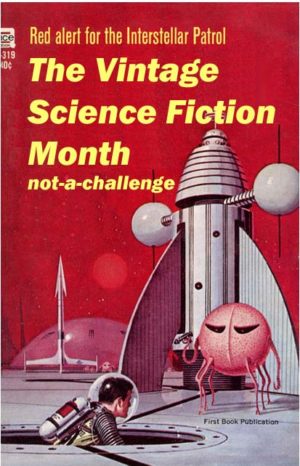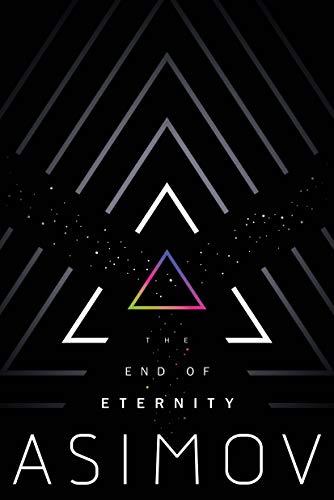Isaac Asimov’s The End of Eternity combines ideas about time travel with a questioning of the direction humanity could or should take over millions of years. However, the big issues about society, the development of humanity and the nature of Eternity are left to the end when a powerful turnabout occurs where expectations and assumptions all shift. Before that, most of the story rivets attention on the manipulation of reality by a group of Eternals who change history to keep humans from what they regard as some of their worst excesses.
Unlike many time travel stories where protecting the existing timeline is paramount, the whole point of traveling through centuries in The End of Eternity is to change the course of history. Asimov is at his ingenious best in detailing the painstaking process of designing the specific changes the Eternals make and the way their society is constructed.
It’s a masterful performance, but as with all the Asimov novels I’ve read, ranging from the original Foundation trilogy to the robot stories and robot/detective novels, like The Naked Sun, there are serious limitations. I’ll get to those in a minute.
Asimov’s Eternity is a realm operated by a cadre of disciplined experts who live outside of time, though they are themselves mortal. They can move by means of a sort of time elevator called a kettle to any century, any time, either “upwhen” (millions of years in the future) or “downwhen” (as far back as humans existed).
They do this to introduce precisely calculated changes to subtly shift the course of history. Their goal is to preserve the greatest good for society as a whole, even if that means lives will be erased as a result of their interventions. Even though these men (and they are all men) live in Eternity, they can pass in and out of time as needed. Their bodies are subject to aging, or physiotime, so they need a steady supply of new recruits.
Since there are no women in Eternity, they must take these recruits out of time. These Timers, who will never return to their home centuries, train from their teens, as Cubs, then move on to be Observers with the crucial job of gathering the precise facts on which changes can be based. Then they become Specialists, such as Sociologists, Technicians and Computers. These are the leading classes of experts who first study the centuries looking for problems, then measure the precise type of intervention and finally travel to the relevant century to make the change in reality.
Technicians are the Specialists who step in and out of Eternity to make adjustments in the world of a particular century. They calculate the Minimum Necessary Change to effect the Maximum Desired Response. The change could be as simple as shifting the position of an object on a shelf, or delaying someone from being in a certain place by just a few moments.
Their work is supported by thousands in Maintenance, who were Cubs that didn’t make the grade for advancement, but whose skill and comprehensive knowledge of how Eternity works keeps everything running. It’s a completely stratified society, overseen by the Allwhen Council, consisting of a handful of Computers (the highest ranking Specialists), who must approve all major interventions in time.
Asimov skillfully introduces all this background through a series of dramatic encounters and conversations in which the characters are trying to get something from each other. For Eternals are not emotionless beings coldly carrying out their duties. They are full of jealousy, spite, anger, competitiveness, and, while meticulous in doing their work accurately, suffer through their own forms of politicking with each other.
The central character is Andrew Harlan, a Technician of flawless skills, who is introduced in the midst of his plans to commit a terrible crime against Eternity, though it takes quite a while before we find out what that crime is. All that we know is that it involves a woman named Noÿs and could threaten the very existence of Eternity.
Here is one of those familiar problems in Asimov’s work. He shares the limits of most white, male SFF writers of the 1950s in either leaving women out of their stories altogether or reducing them to one of a few stereotypes. At first, Asimov seems to be doing the same thing. There is a single woman, who initially appears only as a “babe” to become the love interest and primary motivator of the central character. Harlan falls for her so deeply, he feels she is a part of himself and will do anything to create a space in Time where they can be together. To keep her “safe” while he works out the details of his plan, he puts her in a remote future century about which little is known (deep in the 100,000s) and where there seem to be no other people. As far as we (and he) know, she just waits there for his return.
Then Harlan surreptitiously goes about making his adjustments, but just when he wants to get back to Noÿs, he finds there is a mysterious barrier preventing the kettle from reaching past the 100,000th century. He believes he’s been found out, that the other Specialists have been playing him for a fool for their own purposes, but the truth is far different and unfolds into a compelling part of the story. Noÿs ultimately becomes the most important person in the novel, though it strikes me that Asimov still leaves her with a conventional male conception of the 1950s about the future she wants with Harlan.
Nevertheless, The End of Eternity is pretty compelling in its revelations and pacing, if you can tolerate the way Noÿs is introduced and disappears for most of the story while the men set about doing the real work. I think this is one of Asimov’s very best novels, but it’s hard to look past its dated aspects.






Thank you for sharing your perspective in this Sci Fi novel about Reality Changes. I can’t stop myself from imagining an Alternate Reality in which Asimov’s analogue, a woman named Judith Asimova, wrote a very similar novel in which she depicted a male-dominated society of Eternals, showed how that society was defective (and indeed, caused the extinction of the human species) and also showed how a single woman could destroy the Reality of the Eternals and replace it with a new Reality in which humans could spread infinitely through the stars. And decades later, In her Reality, I wonder if Judith Asimova’s novel would be “problematical” because of her white, male SFF attitudes from the 50s.
Well, I guess we’ll disagree somewhat on this. As someone born in the 1940s, I took a long time before finding anything strange about male-dominated fiction, or life for that matter. I can’t quite buy the plot twist of pulling a character out of the closet at the very end, making her the key to a new future, especially when it’s clear she was sent to Harlan specifically as a seductress to manipulate him to help destroy Eternity. I just don’t see a great change in the underlying attitudes about women. But thank you for responding. I’m no expert on Asimov and need to read more of his work.
The omission of all but one female character is a plot point to set up the ending. Asimov creates Eternity as a pit of childless neurotic/psychotic homeless incels that Andrew understandably gives up in a heartbeat when offered everything Eternity lacks. How likely is it that Andrew would destroy an Eternity that includes his wife and children?
As for Noÿs, we can assume that her people choose a romantic approach to a dissatisfied Technician for the highest probability of success. Accordingly, from the vast number of diverse females in their world, they pick one who wants a husband and (we assume) children. She has the luxury of knowing in advance she falls in love with the target Eternal and will have a happy life with him in the Primitive. In other words, she’s not just fighting for the future of humanity, she’s fighting to save her family.
This is actually a “feminist” novel in the sense that Noÿs is the only character with any real agency.